Showscan: A 70mm High Impact Experience |
Read more at in70mm.com The 70mm Newsletter | ||||||||||||||||||||||||||||||
| Prospectus about Showscan Film Corporation, dated 25.06.1987 | Date: 26.06.2011 | ||||||||||||||||||||||||||||||
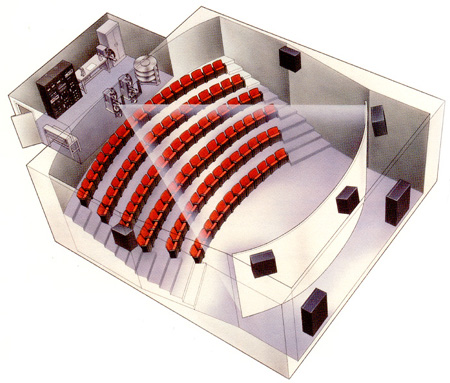 Prototype
of a Showscan High Impact Theatre. 70mm film presented on a curved screen at
60 frames pr. second. Prototype
of a Showscan High Impact Theatre. 70mm film presented on a curved screen at
60 frames pr. second.The Company has acquired and is currently exploiting a patented motion picture filming and projection process called Showscan. Motion pictures filmed and projected using the Showscan process create a visual effect of depth and realism that the Company believes is superior to conventional films. Since its inception, the Company has been primarily engaged in the further development of the Showscan process, equipment and technology necessary to photograph and exhibit Showscan films. To date, the Company's principal source of revenues has been the production and licensing for production of special-venue Showscan films for exhibition at expositions, tourist attractions and corporate presentations. Such presentations have included films shown at Expo '85 in Tsukuba, Japan, Expo '86 in Vancouver, Canada, an exhibit at the CN Tower in Toronto, Canada, and a corporate film and commercial for the Chevrolet Motor Division of General Motors Corporation. |
More in 70mm reading: Showscan Showscan Speciality Theatre Films and Ride Films "New Magic" in 70mm Showscan The Impact of Showscan - Experienced by in70mm.com readers Showscan: The Best 70mm I have ever seen Showscan: The Future is Now - The Future of Feature Film Exhibition Showscan enters liquidation process | ||||||||||||||||||||||||||||||
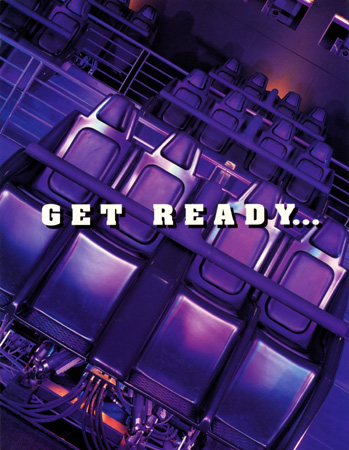 The Company intends to license the Showscan
process in the production, distribution and theatrical exhibition of
feature-length motion pictures, although no such license agreements have
been entered into to date. The theatrical exhibition of such motion
pictures will require that specially equipped theaters capable of
exhibiting Showscan films be established in major film exhibition
markets. Since the visual effects of Showscan currently cannot be
reproduced on video or television, the Company intends to market the
Showscan concept to motion picture producers, distributors and
exhibitors as a means of attracting larger viewing audiences to
feature-length motion picture theaters. The Company intends to use a
portion of the proceeds of this offering to facilitate the production
and exhibition of feature-length Showscan motion pictures. The Company
will not initially engage in the production of any feature-length motion
pictures but, rather, will license the right to others to produce,
distribute and exhibit feature-length
Showscan motion pictures. The Company intends to license the Showscan
process in the production, distribution and theatrical exhibition of
feature-length motion pictures, although no such license agreements have
been entered into to date. The theatrical exhibition of such motion
pictures will require that specially equipped theaters capable of
exhibiting Showscan films be established in major film exhibition
markets. Since the visual effects of Showscan currently cannot be
reproduced on video or television, the Company intends to market the
Showscan concept to motion picture producers, distributors and
exhibitors as a means of attracting larger viewing audiences to
feature-length motion picture theaters. The Company intends to use a
portion of the proceeds of this offering to facilitate the production
and exhibition of feature-length Showscan motion pictures. The Company
will not initially engage in the production of any feature-length motion
pictures but, rather, will license the right to others to produce,
distribute and exhibit feature-length
Showscan motion pictures. |
|||||||||||||||||||||||||||||||
Background | |||||||||||||||||||||||||||||||
 The
70mm projector and 7000 watt lamp house are manufactured by Century
Projectors Corporation. Image from the Showscan brochure The
70mm projector and 7000 watt lamp house are manufactured by Century
Projectors Corporation. Image from the Showscan brochureGeneral. The illusion of movement in motion pictures is created by filming a series of still photographs in rapid succession and then projecting those pictures onto a screen. The rate at which the film frames are flashed onto the screen and the size of the film frame affect the quality of the projected image. Since Thomas Edison designed the 35mm film format in 1890, 35mm film has been the accepted standard format for the photography and theatrical exhibition of motion pictures. The original silent motion pictures were usually filmed and shown at a frame rate of 16 frames per second (fps). However, opening and closing the shutter 16 times per second created flicker on the screen. In order to avoid flicker, each frame was shown three times before the next frame was shown, resulting in 48 flashes being projected per second. When sound was added to motion pictures in the late 1920s, a faster frame rate was needed so that the sound track on the film could move fast enough past the sound head to produce acceptable sound fidelity. The standard that was adopted was 24fps, with each frame being shown twice, also resulting in 48 flashes being projected per second. This standard of projecting 35mm film at 24fps remains the standard today. As theater screen sizes increased, the graininess of the film became more noticeable. In the 1950s, some films were photographed on 65mm film and projected at 24fps on 70mm film in order to increase clarity. In addition, new film projection techniques, including Vista Vision (two 35mm frames projected horizontally as a single frame), Cinerama (three separate projectors using 35mm film) and Todd-AO (70mm film photographed and projected at 30fps), were tried. In order to reduce film production costs, 65mm filming was largely discontinued in the 1960s. Accordingly, at present, most films exhibited in 70mm are photographed using 35mm film and then enlarged to 70mm. |
|||||||||||||||||||||||||||||||
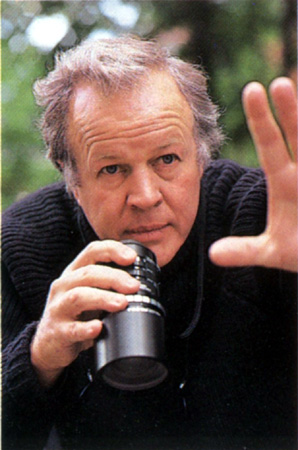 Douglas
Trumbull, father of the Showscan process, from the Schowscan brochure, dated early 1990s Douglas
Trumbull, father of the Showscan process, from the Schowscan brochure, dated early 1990sDevelopment of the Showscan Process. The development of the Showscan process was begun in 1975 by Douglas Trumbull while he was associated with Paramount Pictures Corporation ("Paramount"). Paramount formed a subsidiary, Future General Corporation ("FGC"), to develop and eventually exploit the Showscan process. In 1978, FGC granted Mr. Trumbull a license to the Showscan process in order to proceed with the further development of the process. In 1981, Mr. Trumbull entered into a joint venture for the future development of the process with Showscan Investors, a limited partnership unaffiliated with the Company (which has since been reconstituted as WLS Partners). In 1983, Brock Hotel Corporation ("Brock"), a corporation engaged in the business of owning and operating hotels and pizza parlors, installed mini-theaters in certain of its "ShowBiz Pizza Place" restaurants in order to exhibit short Showscan films. In order to provide the Showscan films to the pizza parlors, Brock and Mr. Trumbull formed Brock/Trumbull Entertainment Corporation ("Brock/Trumbull") in August 1983. Brock/Trumbull purchased the rights of Showscan Investors in the Showscan process in exchange for the future royalty payments described in "Business—Royalty Arrangements." The Company was formed in August 1984 by Henry Plitt and Roy Aaron, who were then affiliates of a major theater chain, in order to acquire the right to use the Showscan process in feature-length motion pictures to be exhibited in their first-run motion picture theaters and in theaters of others. |
|||||||||||||||||||||||||||||||
The Showscan Process | |||||||||||||||||||||||||||||||
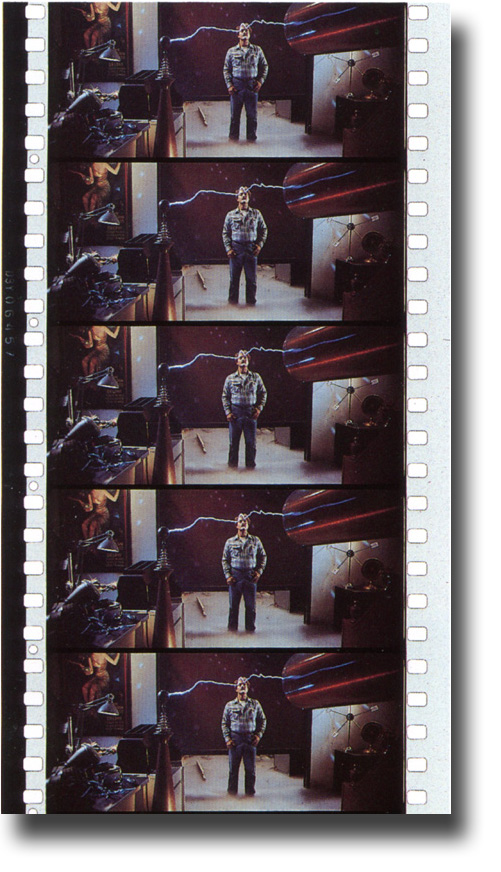 70mm
clip from "New Magic" which represent 1/12th of a second. Note the
large image
area where every frame is shown only once. The amount of image information is staggering compared to the same
clip in 35mm. 70mm
clip from "New Magic" which represent 1/12th of a second. Note the
large image
area where every frame is shown only once. The amount of image information is staggering compared to the same
clip in 35mm. In contrast to conventional filming and projection systems, a Showscan motion picture is photographed on 65mm film at a rate of 60fps and is projected using 70mm film at a rate of 60fps and at a higher illumination level. (The 65mm film is projected using 70mm film in order to accommodate the sound track that occupies approximately 5mm of the film strip.) In addition, each frame in a Showscan film is shown only once. Accordingly, a Showscan film projects images 2.5 times faster and significantly brighter and larger than standard 35mm film. The brighter image and increased visual cues perceived by the viewer of a Showscan film result in greater picture clarity and an enhanced sense of dimensionality and realism. Photography on 65mm film at a frame rate of 60fps offers a number of improvements in the quality of a motion picture image and permits the screen size to be substantially enlarged without significant degradation. The images can be significantly brighter, rendering the colors in the film much more saturated and vibrant, and motion of the cameras and the subject can be substantially increased without distortion, greatly heightening the impact of action scenes. The larger 70mm format and faster exposure time also greatly reduce blurring, thus recording accurately and in fine detail all the performers, costumes, locations, sets and props. In order to maximize the visual impact and to convey stronger visual cues, a Showscan film is projected onto a specially designed curved screen that is approximately twice as wide as it is high. Such a screen, when installed in a conventional motion picture theater, would be approximately twice the height and width of a conventional screen and would extend from the floor to the ceiling of the theater. |
|||||||||||||||||||||||||||||||
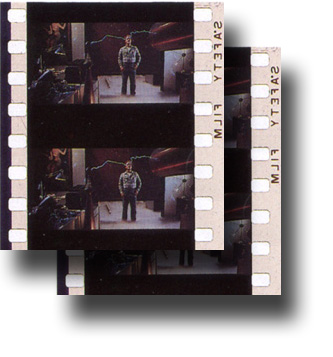 The
same 1/12th of a second sequence as above, but in (sub standard) 35mm.
Every 35mm frame is shown twice (illustrated here with two 35mm clips
above each other). Note how ridiculously small the image area really is
compared to the 70mm clip. In this example, Showscan also exaggerated
the difference by showing a cropped widescreen 35mm image, rather than
an anamorphic 70mm-to-35mm printdown. The
same 1/12th of a second sequence as above, but in (sub standard) 35mm.
Every 35mm frame is shown twice (illustrated here with two 35mm clips
above each other). Note how ridiculously small the image area really is
compared to the 70mm clip. In this example, Showscan also exaggerated
the difference by showing a cropped widescreen 35mm image, rather than
an anamorphic 70mm-to-35mm printdown. In order for viewers to obtain an, unobstructed view of the entire screen, with realistic lines of view and correct perspective, the theater's seats should face the center of the screen and the floor should slope more steeply than in most existing theaters. Therefore, the Company believes that most existing theaters will have to redesign their seating arrangements to fully accommodate the exhibition of a Showscan motion picture. The effects of realism produced by a Showscan motion picture are enhanced by a sound system not ordinarily installed in conventional motion picture theaters. Such a discrete six-channel sound system is assembled by the Company using currently available high-quality speakers and amplifiers. Since motion picture theaters are equipped for conventional sound technology in which the sound track is placed on the space available on the motion picture film print, the Company recently developed the capability of placing the sound track on 70mm Showscan film. The sound track is an analog recording on magnetic tape. Because the Showscan process uses 2.5 times more film than standard 24fps motion pictures, there is more space available on the film for the sound track. Accordingly, the sound track on Showscan film has a greater dynamic range than a conventional sound track on 24fps film. |
|||||||||||||||||||||||||||||||
Applications of the Showscan Process | |||||||||||||||||||||||||||||||
|
Feature-Length
Motion Pictures. The Company believes that the greatest long-term
potential economic benefit to be derived from the Showscan process is
from feature-length motion pictures. Recently, domestic theatrical exhibition has faced increased competition for viewers, largely because of the increasing importance of pay and cable television and home video entertainment. Because the unique characteristics of the exhibition of a Showscan film cannot currently be reproduced on video or on television, the Company intends to market Showscan films as a means of increasing audiences at specially equipped motion picture theaters. In addition, since Showscan motion pictures can be adapted for use in conventional movie theaters, cable, pay and commercial television, and the videocassette market, Showscan motion pictures also will be distributed to these markets. However, a Showscan film converted to a slower frame rate or another medium would not contain the depth and realism of the Showscan process. Initially, the Company intends to market the Showscan process to producers of action, adventure and other films that feature special effects. However, the Company believes that the clarity and sense of reality produced by Showscan films will also be attractive to producers of high-quality dramatic films. To date, no feature-length Showscan motion pictures have been produced and no agreements to produce such films have been negotiated. The Company does not currently intend to produce or distribute feature-length Showscan motion pictures itself. Rather, the Company plans to license the rights to produce, distribute (in the foreign and domestic markets) and exhibit Showscan motion pictures. The Company anticipates that the licensing fees for the production, distribution and exhibition of feature-length Showscan motion pictures will be based on a percentage of box office receipts earned by the producers or distributors from exhibition at Showscan theaters. The Company anticipates that the theater licenses initially will be allocated so as to provide Showscan exhibitors with a degree of territorial exclusivity. The Company has not yet established any licensing fee schedules or entered into any licensing arrangements, and no assurance can be given that such licensing arrangements will be entered into or that the Company will derive any revenues from any such licenses. |
|||||||||||||||||||||||||||||||
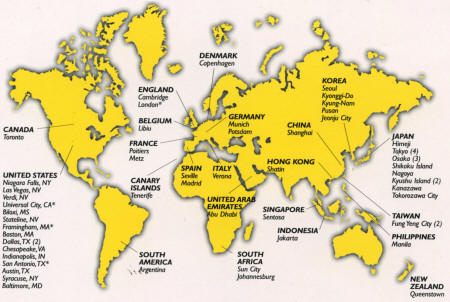 Worldwide
installations by 1994. Image from the Showscan brochure. Worldwide
installations by 1994. Image from the Showscan brochure.Click image to see enlargement. Production of Showscan Motion Pictures. The cost of producing and distributing a Showscan motion picture typically will exceed the cost of producing the same motion picture in the conventional 35mm and 70mm formats. Most of the additional expense will be incurred in the higher cost of film negatives, laboratory processing and film prints. The Showscan process requires that a motion picture be filmed on 65mm film rather than on the standard, and less expensive, 35mm film. The process also requires that the film travel through the camera at a rate 2.5 times faster than in a conventional camera, thereby requiring more film for the photography of the motion picture. The Company estimates that these additional expenses could add a minimum of approximately $2,000,000 to $3,000,000 to the production costs of an average feature-length motion picture. Showscan motion pictures must be photographed with a camera that can accommodate 65mm film traveling at a rate of 60fps. Existing cameras have been modified to film Showscan motion pictures. In addition, the Company owns a 65mm camera, the CP-65, designed to the Company's specifications for filming Showscan motion pictures. This motion picture industry equipment can be operated by cameramen accustomed to using conventional cameras. The Company intends to use approximately $1,800,000 of the proceeds of this offering to purchase four additional CP-65 cameras and related accessory equipment that the Company will use to photograph Showscan films or rent to producers of Showscan films. As of the date hereof, only one CP-65 camera has been manufactured and used. |
|||||||||||||||||||||||||||||||
|
A significant drawback to producing a motion
picture using the Showscan process has been the inability to convert a
Showscan film to the standard 24fps format for exhibition in
conventional theaters or on television, or for reproduction on home
videocassettes. The Company recently developed the technology for
converting Showscan film to conventional film and videocassettes, thus
making Showscan motion pictures available for exhibition in all motion
picture theaters, on television and in all ancillary markets. Such
converted film does not, however, contain the depth and realism of a
Showscan film exhibited in Showscan theaters. In consideration of the loans in the aggregate principal amount of $1,750,000 made by Columbia to the Company, the Company has granted to Columbia, through June 12, 1989, the right to negotiate with the Company to produce and distribute up to two feature-length motion pictures utilizing the Showscan process. Such right can be exercised when Columbia has developed a motion picture property that it wishes to produce and distribute as a Showscan feature-length motion picture. In addition, as long as Columbia has the rights described in the preceding sentence, the Company is obligated to give Columbia notice of any negotiations that it has entered into with a third party for the production and distribution of a Showscan feature-length motion picture and the Company may not enter into a binding agreement with such third party until Columbia has had the opportunity to negotiate with the Company towards such an agreement. See "Management's Discussion and Analysis of Financial Condition and Results of Operations—Liquidity and Capital Resources." |
|||||||||||||||||||||||||||||||
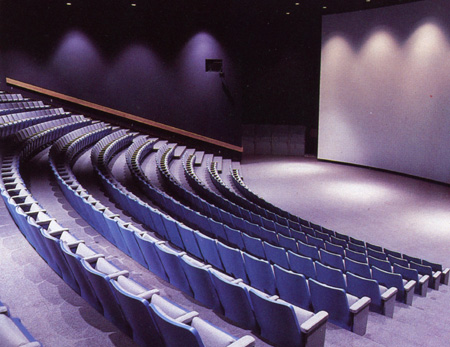 500
seat Discovery Theatre, EXPO 86, Vancouver, British Columbia. Image from the
Showscan brochure. 500
seat Discovery Theatre, EXPO 86, Vancouver, British Columbia. Image from the
Showscan brochure.Exhibition of Showscan Motion Pictures. In order to obtain the maximum visual effects of the Showscan process, motion pictures filmed using the Showscan process must be exhibited on a curved screen with a projection system capable of projecting 70mm film at 60fps. In addition, theaters in which Showscan motion pictures will be exhibited should contain sound systems superior to those generally installed in conventional theaters. Accordingly, before a Showscan feature-length motion picture can be commercially exhibited, theaters in the major film exhibition markets of the United States must be converted or constructed to accommodate Showscan process equipment. Theaters converted to exhibit Showscan motion pictures will continue to be capable of exhibiting conventional 35mm or 70mm motion pictures. The equipment necessary to exhibit a Showscan motion picture in a theater includes a modified projection system and a larger and specially designed curved screen, the aggregate cost of which will differ in each instance depending on the structure and equipment of existing facilities. In addition, in order to enhance the effect of realism in a Showscan theater, the Company will require each theater to improve its sound system. The Company estimates that the purchase price of a new screen, sound system and projection system and the cost of modifying the theater will be in the range of approximately $100,000 to $300,000. However, in the construction of a new theater, the added cost of equipping the theater so that it will be compatible with the Showscan process will be significantly lower than the cost of converting an existing theater. All of the items to be acquired or modified, including the screens, projectors, lamp houses, lenses and components of the sound systems, are currently available from a number of unaffiliated vendors. In order to fully experience the impact of the Showscan process, the seating in the theaters should provide an unobstructed view of the entire enlarged screen. In many existing theaters, this may require rearranging the seating or increasing the slope of the theater's floor. Although the seating arrangements of some existing theaters meet the Company's standards, the Company believes that most theaters will require some modification in their seating arrangements and acoustics, the costs of which will vary with each theater and thus cannot be estimated. |
|||||||||||||||||||||||||||||||
Special-Venue Exhibitions | |||||||||||||||||||||||||||||||
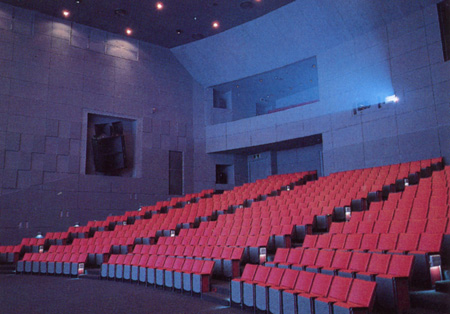 The
FIRST public Showscan cinema. The 540 seat Toshiba Showscan Theatre
in the Toshiba
Pavilion EXPO 85, The International Exposition, Tsukuba, Japan. Image from
the Showscan brochure. The
FIRST public Showscan cinema. The 540 seat Toshiba Showscan Theatre
in the Toshiba
Pavilion EXPO 85, The International Exposition, Tsukuba, Japan. Image from
the Showscan brochure.To date, the Company's principal source of revenues has been in the production, licensing and exhibition of special-venue films. Special-venue presentations are short films, typically 15 to 20 minutes in duration, produced using the Showscan process and exhibited at expositions, fairs, museums and other major tourist attractions. Special-venue theaters are either theaters permanently dedicated to the exhibition of special-venue Showscan films or temporary theaters erected for such purpose. In special-venue theaters, the sound track of a Showscan film is either on a separate six-track, 35mm perforated magnetic tape or on compact laser discs, which are electronically interlocked with the film. Placement of the sound track on a separate piece of film or disc and synchronization of the motion picture and the sound track through the use of an electronic interlock system have enabled special-venue films to utilize a fully dynamic sound system not used in conventional films. |
|||||||||||||||||||||||||||||||
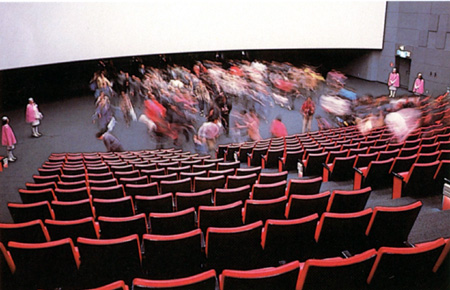 The
FIRST public Showscan cinema. The 540 seat Toshiba Showscan
Theatre with 25,6 m. x 11 m. (84 ft. wide x 36 ft.) high screen. Image from the Showscan brochure. The
FIRST public Showscan cinema. The 540 seat Toshiba Showscan
Theatre with 25,6 m. x 11 m. (84 ft. wide x 36 ft.) high screen. Image from the Showscan brochure.In addition to licensing the right to exhibit the special-venue Showscan films, the Company may also produce the special-venue film, provide post-production services, sell or rent equipment or provide technical assistance in equipping the theaters. Generally, the Company owns the special-venue films or tries to obtain the Showscan distribution rights to such films. The Company intends to distribute such films to the various special-venue Showscan theater operators for a distribution fee based on a percentage of the gross proceeds received by the Company from the exhibition of the films. The income received by the Company from special-venue presentations typically has consisted of a license fee for the right to exhibit the Showscan film, which fee either is a percentage of the exhibitor's gross box office receipts or a negotiated fixed fee, a fee for producing or assisting in the production of the film, and/or rental payments for the use of the Showscan film or equipment. The type of equipment and services provided by the Company for special-venue presentations varies in each instance, and the percentage of the license fee varies depending on the other services provided by the Company and the anticipated duration of the film's presentation. Although the Company regards its special-venue business as nonrecurring in nature, the Company does receive on-going license fees from the permanent special-venue theaters. To date, most of its revenues from special-venue presentations have come from the following exhibitions:
| |||||||||||||||||||||||||||||||
|
The
Company intends to expand its special-venue business to other
exhibitions, amusement parks, tourist centers, museums and other
special-purpose sites that are open to the public. The Company's
principal business objective in developing its special-venue business is
to license the photography and exhibition of films produced in the
Showscan process. However, the Company will continue to provide services
in the development, pre-production, principal photography, special
effects and post-production phases of a film, as well as provide
consulting services and equipment. The Company currently has ten Showscan special-venue films available for exhibition. The Company owns special-venue films, including "Let's Go", "New Magic", "Deep Sea Rescue", "Big Ball", "Night of the Dreams" and "Niagara Wonders", and has obtained the Showscan distribution rights on "Discovery", "Rollercoaster", "Alpine Thrills" and "Kiwi Experience". |
|||||||||||||||||||||||||||||||
Corporate Presentations | |||||||||||||||||||||||||||||||
|
The Company is marketing the Showscan process for
use in corporate conventions, trade shows and other industrial
presentations. In 1986, the Company produced and delivered a one-hour Showscan film and a commercial for Chevrolet's 75th Anniversary Dealer Show in Orlando, Florida. The commercial was subsequently converted to the standard 35mm format and exhibited in motion picture theaters nationwide. The Showscan version of the commercial and footage from the film have been and are being exhibited by the Chevrolet Motor Division of General Motors Corporation in auto shows in Detroit, Chicago, Cleveland and New York. |
|||||||||||||||||||||||||||||||
Dynamic Motion Theaters | |||||||||||||||||||||||||||||||
 Image
from the Showscan brochure. Image
from the Showscan brochure.Intamin Corporation Inc. Est. ("Intamin"), a Liechtenstein corporation that is a manufacturer of amusement park rides, has developed hydraulically actuated theater seats that can be synchronized with a film image projected onto a screen in front of the seats. By synchronizing the motion of hydraulic seats with the projection of an action Showscan film, the Company and Intamin have been able to simulate the experience and motion of a ride, such as a roller coaster, a racecar or a submarine. The theaters in which such mechanized seats and Showscan equipment are installed are called Dynamic Motion Theaters. The Company and Intamin anticipate that Dynamic Motion Theaters will be established to simulate a series of approximately two to four minute action rides and intend to market the theater to amusement centers, tourist attractions and other locations frequented by large numbers of people, possibly including shopping centers. The Company, in conjunction with Intamin, has filed a patent application with respect to the mechanism for moving theater seats. Although the development of the hydraulically actuated seats has been completed and a number of prototypes of the seats have been manufactured, the production of additional seats has been held in abeyance pending the receipt of firm commitments for the establishment of commercial Dynamic Motion Theaters. |
|||||||||||||||||||||||||||||||
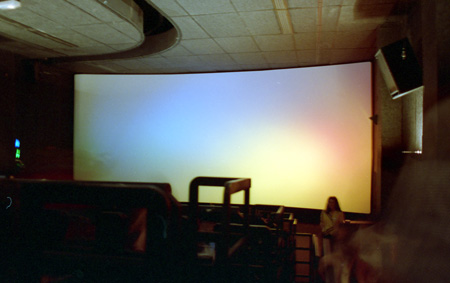 Curved
Showscan screen at the Dynamic Motion Theater
in Poitiers in France, 1992. Image by Thomas Hauerslev Curved
Showscan screen at the Dynamic Motion Theater
in Poitiers in France, 1992. Image by Thomas HauerslevIn June 1986, the Company and Intamin entered into an agreement to market the Dynamic Motion Theater concept and manufacture and install mechanized seats and projection equipment in Dynamic Motion Theaters worldwide. Pursuant to this agreement, Intamin will manufacture the hydraulic seats and the Company will provide the Showscan films, projection equipment, screens, sound system and computerized motion synchronizer, supervise the installation of Showscan equipment and train personnel to operate the equipment. Both the Company and Intamin are authorized to market Dynamic Motion Theaters. In consideration for its marketing services, Intamin will receive a commission based on a percentage of the film rental received by the Company from Dynamic Motion Theaters. |
|||||||||||||||||||||||||||||||
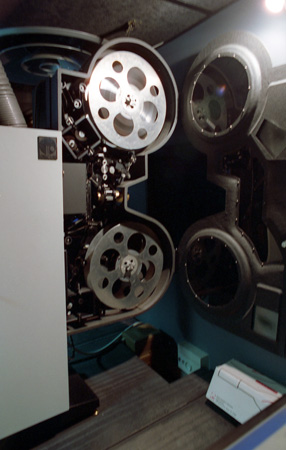 Showscan
projector at the Dynamic Motion Theater
in Poitiers in France, 1992. Image by Thomas Hauerslev Showscan
projector at the Dynamic Motion Theater
in Poitiers in France, 1992. Image by Thomas HauerslevThe Company has designed Dynamic Motion Theaters for 45 to 90 seats. Although no permanent Dynamic Motion Theaters have been established to date, the Company has operated temporary 16-seat theaters for the Chevrolet Motor Division of General Motors Corporation at the Chevrolet 75th Anniversary Dealer Show and in a temporary theater at the Chevrolet plant in Detroit, Michigan. At the International Association of Amusement Parks and Attractions convention held in November 1986, an eight-seat demonstration Dynamic Motion Theater was awarded first prize for a major ride introduced at the convention. The Company is developing a library of short action films for exhibition in Dynamic Motion Theaters. Films currently owned by the Company include films for a roller coaster ride, a car chase, a runaway train, underwater experiences, a dune buggy ride, downhill skiing and flight simulation. |
|||||||||||||||||||||||||||||||
Showscan Equipment | |||||||||||||||||||||||||||||||
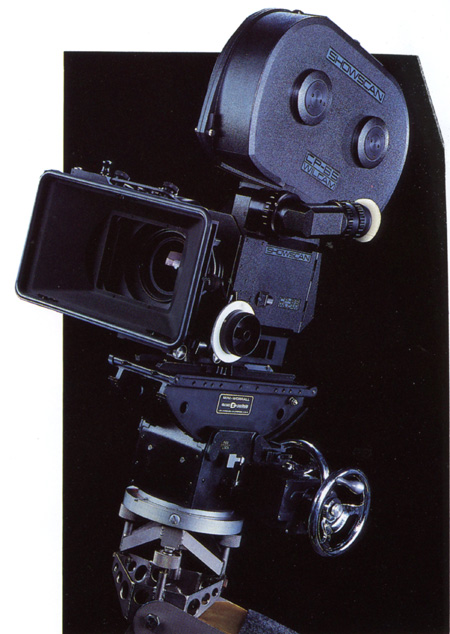 The
CP-65 highspeed, crystal-synchronized spinning mirror reflexed studio
Showscan 65mm camera. The prototype of the CP-65 camera is manufactured
exclusively for the company by Cinema Prosucts Corporation. Image from the Showscan brochure. The
CP-65 highspeed, crystal-synchronized spinning mirror reflexed studio
Showscan 65mm camera. The prototype of the CP-65 camera is manufactured
exclusively for the company by Cinema Prosucts Corporation. Image from the Showscan brochure.The photography and exhibition of Showscan motion pictures require specially equipped or modified cameras and projectors. In addition, certain other products and equipment are needed to produce Showscan motion pictures and to convert Showscan film to standard film. The Company has designed or assisted in the design of Showscan-related equipment. Cinema Products Corporation ("Cinema Products"), a manufacturer and supplier of professional motion picture cameras and equipment, has developed and built a 65mm high-speed camera for the Company. The camera, called "CP-65," is being used to photograph Showscan films. The CP-65, a highspeed, crystal-synchronized spinning mirror reflexed studio camera, is available with a full complement of lenses and associated support equipment and is compatible with standard motion picture industry equipment. The camera can be operated at various speeds from 2fps to 72fps and is crystal-synchronized at 24, 30 and 60fps. To date, only one prototype of the CP-65 has been manufactured for the Company. The Company currently does not intend to sell any CP-65 cameras, but, rather, intends to rent the cameras. Cinema Products has agreed to act as the Company's rental agent and will, at its cost, perform all maintenance on the CP-65 cameras. For the foregoing rental and maintenance services, Cinema Products will receive a fee equal to 40% of gross receipts from the rental of the cameras. Although the Company owns the rights to the camera and its design, it has agreed to pay Cinema Products 25% of the Company's remaining share (60%) of net revenues received from the rental of the cameras. The Company has the right to terminate its obligation to pay 25% of such net revenues by paying Cinema Products $486,000 ($536,000 after January 1, 1990) less one-half of all amounts previously paid by the Company to Cinema Products in respect of such rental payments. Films produced using the Showscan process can be projected with certain conventional 70mm projectors that are modified to project a motion picture at 60fps. The modification does not entail significant expense nor effort and does not have an adverse effect on the reliability of the projector. In order to facilitate the projection of short films in special-venue theaters and in Dynamic Motion Theaters, the Company retained outside contractors to develop for the Company an automatic electronic projector that uses low-inertia motors to achieve the intermittent projection of frames of film rather than the conventional use of gears and geneva-drive sprockets. The projector permits computer-controlled automatic cueing, synchronization and rewinding necessary for the continuous showing of a series of short films. The Company has applied for a patent on certain circuitry included in its projector. |
|||||||||||||||||||||||||||||||
Research and Development | |||||||||||||||||||||||||||||||
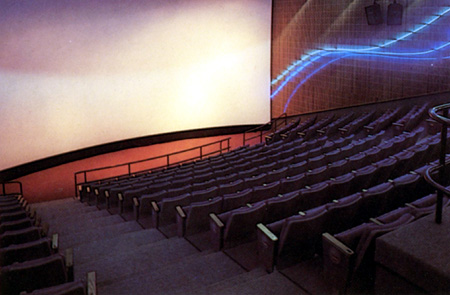 "Centennial
Theatre" opened May 1987. 300
seat Festival Theatre, Niagra Falls, USA. Image from the Showscan
brochure. "Centennial
Theatre" opened May 1987. 300
seat Festival Theatre, Niagra Falls, USA. Image from the Showscan
brochure.Since its inception, the Company has engaged in the further development of the Showscan process, equipment and technology necessary to photograph and exhibit Showscan films. In addition, the Company, directly or in conjunction with other companies, is engaged in a continuing program of research and development to develop new equipment and to improve and enhance existing motion picture techniques. |
|||||||||||||||||||||||||||||||
Marketing | |||||||||||||||||||||||||||||||
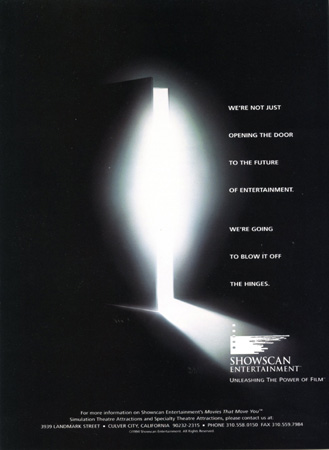 To date the Company has expended only a limited
amount of its financial resources on the marketing of the Showscan
process. Its marketing efforts have consisted primarily of the
distribution of sales brochures and the demonstration of the Showscan
process at its own studio and at trade shows and conventions, including
the 1986 ShoWest motion picture convention. The Company currently has
three full-time marketing employees as well as independent marketing
representatives. Dynamic Motion Theaters are being marketed by both
Intamin and the Company. To date the Company has expended only a limited
amount of its financial resources on the marketing of the Showscan
process. Its marketing efforts have consisted primarily of the
distribution of sales brochures and the demonstration of the Showscan
process at its own studio and at trade shows and conventions, including
the 1986 ShoWest motion picture convention. The Company currently has
three full-time marketing employees as well as independent marketing
representatives. Dynamic Motion Theaters are being marketed by both
Intamin and the Company.A portion of the proceeds from this offering has been allocated for the expansion of the Company's sales and marketing efforts. It is anticipated that the funds will be used mainly for additional demonstrations of the Showscan process as well as for new marketing materials and sales brochures. The Company also intends to commence active marketing of the Dynamic Motion Theaters. In 1985, a prototype of the Company's electronic projector did not operate reliably when installed in a special-venue simulator. Although subsequent generations of this electronic projector are operating satisfactorily, this prior problem may make the Company's marketing efforts more difficult. |
|||||||||||||||||||||||||||||||
Competition | |||||||||||||||||||||||||||||||
 Close
up of Showscan ride film 70mm projector in Denmark 1995. Image by Thomas
Hauerslev Close
up of Showscan ride film 70mm projector in Denmark 1995. Image by Thomas
HauerslevThe Company faces intense competition in all of its business activities. In the area of feature-length motion pictures, Showscan films will compete with conventionally produced feature-length motion pictures, as well as with motion pictures exhibited in 70mm, with THX-enhanced sound systems, Sensurround and with other special features. In addition, the Company's films may also compete with motion pictures produced in FuturVision, a 70mm, 30fps filming and projection process that also uses larger screens and requires modifications to existing theaters and projectors, after such motion pictures are produced and such modifications are made. Because the frame rate used in FuturVision is slower than that of the Showscan process, producing motion pictures in FuturVision is expected to be less expensive than the Showscan process. Since each motion picture is a separate and distinct product, the success of which depends on public response to that picture and the popularity of other motion pictures then being distributed, each Showscan motion picture will compete on its individual content and artistic value as well as on its visual characteristics. In addition, all motion pictures compete for audiences with television, videocassettes and other forms of leisure-time entertainment. |
|||||||||||||||||||||||||||||||
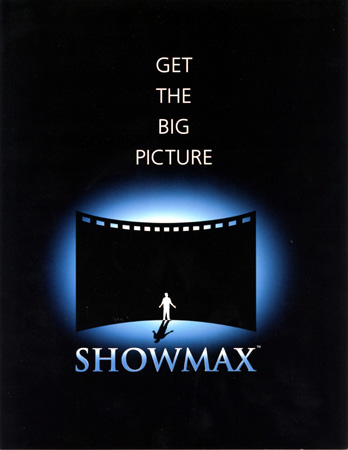 Another
Showscan product - a 70mm 15 perf IMAX clone. Image from the Showscan
brochure. Another
Showscan product - a 70mm 15 perf IMAX clone. Image from the Showscan
brochure.In the area of special-venue presentations, the Company will compete with other big screen and special projection systems, such as the motion picture production and projection processes known as IMAX (for flat-screen projections) and OMNIMAX (for curved-screen projections) and other newly developed formats for projecting motion pictures, such as OMNI-Z, Omnivision and FuturVision. The IMAX and OMNIMAX motion pictures are projected on screens of up to seven stories high and 100 feet wide, and are exhibited in special theaters designed to accommodate the IMAX and OMNIMAX formats. As with the Company's special-venue sound system, FuturVision, IMAX and OMNIMAX use multi-channel sound systems and a separate, electronically synchronized tape for their soundtrack. IMAX, OMNIMAX and Omnivision are established in the special-venue markets and numerous theaters currently exhibit films produced in these formats. The Company believes that FuturVision and Omnivision films will have a price advantage over Showscan process films. However, the Company believes that the Showscan process will have a competitive advantage over all of the foregoing processes in its picture quality and in its visual effect of depth and realism. The Company's corporate presentations will compete with all other techniques used in advertising, public relations and corporate communications. Although an established market for simulator theaters does not yet exist, the Company is aware of several other companies that are marketing simulator theaters which will compete with the Company's Dynamic Motion Theater. Nearly all of the Company's competitors and potential competitors are well established, have substantially greater financial and other resources than the Company and have an established reputation for success in the development and marketing of products that are competitive with those of the Company. There can be no assurance that the Company will be able to compete successfully with such other companies or that it will achieve profitability. |
|||||||||||||||||||||||||||||||
Patents and Service Mark | |||||||||||||||||||||||||||||||
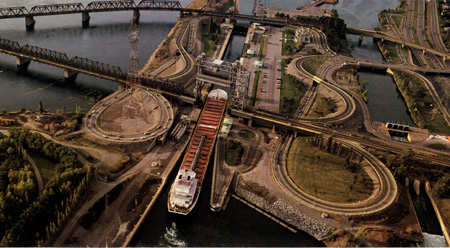 The Company owns two United States patents on the
Showscan process. These patents cover the combined process of (i)
filming and projecting film at a constant frame rate of at least 50fps,
(ii) projecting such film at high illumination, and (iii) using film
containing images of high-resolution. These patents expire in October
2001. The patents are important to the Company because it believes that
a frame rate of 50fps or more is necessary to achieve the desired degree
of depth and realism, and that enforcement of these patents will prevent
others from achieving the same result. There can be no assurance that
the Company's patents, if challenged, will be upheld, nor can there be
any assurance that competitors will not develop a different technology
that offers comparable or competing visual effects. Moreover, the
Company may be unable, for financial or other reasons, to enforce its
rights under its patents. The Company owns two United States patents on the
Showscan process. These patents cover the combined process of (i)
filming and projecting film at a constant frame rate of at least 50fps,
(ii) projecting such film at high illumination, and (iii) using film
containing images of high-resolution. These patents expire in October
2001. The patents are important to the Company because it believes that
a frame rate of 50fps or more is necessary to achieve the desired degree
of depth and realism, and that enforcement of these patents will prevent
others from achieving the same result. There can be no assurance that
the Company's patents, if challenged, will be upheld, nor can there be
any assurance that competitors will not develop a different technology
that offers comparable or competing visual effects. Moreover, the
Company may be unable, for financial or other reasons, to enforce its
rights under its patents.The Company also has filed patent applications relating to the the rapid startup feature of the CP-65 camera, its process for converting high frame-rate film to standard frame-rate film and its device for projecting a 360-degree motion picture image. In addition, the Company, in conjunction with Intamin, has filed a patent application with respect to the mechanism for moving theater seats. If granted, these patents would provide the Company with the exclusive rights to other aspects of its business. The failure to obtain these additional patents will not, however, have a material impact on the Company's operations. Although the Company has filed additional patent applications for the Showscan process in Japan, Australia, Canada and under the European Patent Convention, the Showscan process has not yet received patent protection in any of these jurisdictions and no assurance can be given that any additional patents will be granted. Although the Company believes that its technology has been independently developed and does not infringe the patents of others, certain of the Company's processes could infringe patents, in which event the Company may be required to modify its design or obtain a license. No assurance can be given that the Company will be able to do so in a timely manner or upon acceptable terms and conditions; and the failure to do either of the foregoing could have a material adverse effect upon the Company's business. The Company has filed an application with the United States Patent and Trademark Office to register its service mark Showscan. |
|||||||||||||||||||||||||||||||
Royalty Arrangements | |||||||||||||||||||||||||||||||
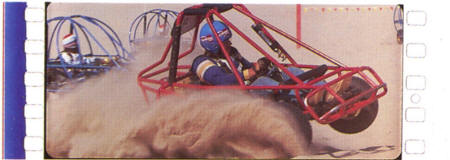 70mm
Showscan frame. Image from the Showscan
brochure. 70mm
Showscan frame. Image from the Showscan
brochure.Showscan Investors. Among the obligations entered into by the Company in connection with the acquisition of its assets is a royalty agreement (the "Royalty Agreement") between the Company and Showscan Investors (which has since been reconstituted as WLS Partners). The Royalty Agreement requires that the Company pay Showscan Investors a royalty based upon the gross receipts to the Company from the exploitation of any motion pictures produced using the Showscan process. The royalty is 3% of such gross receipts until Showscan Investors has been paid a sum of $1,750,000, and 1½% of such gross receipts thereafter until Showscan Investors has been paid an additional $1,750,000. There is no further royalty obligation after the foregoing payments have been made in full. Under the Royalty Agreement, the Company is obligated to make $175,000 annual minimum guaranteed payments to Showscan Investors as advances against the foregoing royalty on each July 31 through the period ending July 31, 1995. To date, the Company has paid $250,000 in royalties under the Royalty Agreement. |
|||||||||||||||||||||||||||||||
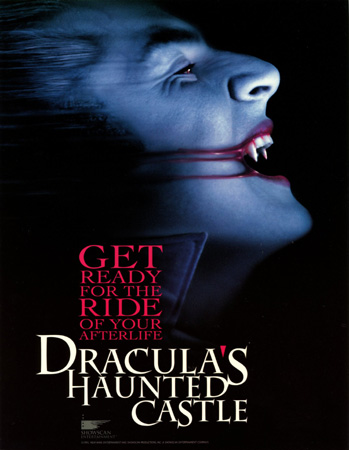 Paramount/Future General Corporation. On June
27, 1985, in connection with the Company's acquisition of the rights to
the Showscan process, the Company entered into an agreement with
Paramount and FGC pursuant to which the Company is obligated to pay FGC
$766,667 on the date of "commencement" of principal photography on each
of the first three motion pictures produced using the Showscan process,
for a total payment of $2,300,000. This $2,300,000 obligation will
become due and payable in June 1991, even if no photography of
feature-length Showscan motion pictures has commenced. In addition, the
Company is obligated to pay FGC a royalty, in perpetuity, equal to 2% of
the Company's gross receipts from the "worldwide exploitation" of the
Showscan process in excess of 180% of the sum of (i) $21,000,000 and
(ii) all cash contributions to the capital of the Company made by June
27, 1987, plus, to the extent such cash payments are not made from item
(ii) above, (iii) the Company's actual cost, if any, of converting and
equipping theaters for exhibition of Showscan motion pictures, and (iv)
Showscan feature-length motion picture production costs incurred by the
Company. For the purpose of determining FGC's royalty, gross receipts
are denned as all monies received by the Company from the exploitation
of the Showscan process, provided that if the Company is the exhibitor
of a Showscan film, gross receipts shall mean one-half of box office
receipts less taxes paid. Paramount/Future General Corporation. On June
27, 1985, in connection with the Company's acquisition of the rights to
the Showscan process, the Company entered into an agreement with
Paramount and FGC pursuant to which the Company is obligated to pay FGC
$766,667 on the date of "commencement" of principal photography on each
of the first three motion pictures produced using the Showscan process,
for a total payment of $2,300,000. This $2,300,000 obligation will
become due and payable in June 1991, even if no photography of
feature-length Showscan motion pictures has commenced. In addition, the
Company is obligated to pay FGC a royalty, in perpetuity, equal to 2% of
the Company's gross receipts from the "worldwide exploitation" of the
Showscan process in excess of 180% of the sum of (i) $21,000,000 and
(ii) all cash contributions to the capital of the Company made by June
27, 1987, plus, to the extent such cash payments are not made from item
(ii) above, (iii) the Company's actual cost, if any, of converting and
equipping theaters for exhibition of Showscan motion pictures, and (iv)
Showscan feature-length motion picture production costs incurred by the
Company. For the purpose of determining FGC's royalty, gross receipts
are denned as all monies received by the Company from the exploitation
of the Showscan process, provided that if the Company is the exhibitor
of a Showscan film, gross receipts shall mean one-half of box office
receipts less taxes paid.The Company also agreed to grant Paramount a license to produce a Showscan feature-length motion picture if the Company grants any other producer such a license before the Company has paid Paramount $2,300,000. The license fee payable by Paramount will be 75% of the license fee charged to such other producer. Paramount also has the right of first negotiation with respect to distribution of the first three Showscan motion pictures produced by the Company if the Company elects to grant any distribution rights to a third-party distributor. Douglas Trumbull. In connection with the Company's acquisition of the Showscan process patents from Douglas Trumbull, the Company entered into an agreement with Mr. Trumbull that provides for payment of royalties to Mr. Trumbull for a period of 30 years, subject to the maintenance of certain levels of working capital. In general, the royalty payable to Mr. Trumbull will equal 1% of all revenues received by the Company from the "worldwide exploitation" of the Showscan process, except that if the Company operates a full-length motion picture theater, Mr. Trumbull will be entitled to 1% of the box office receipts of that theater. |
|||||||||||||||||||||||||||||||
Plan of Operation | |||||||||||||||||||||||||||||||
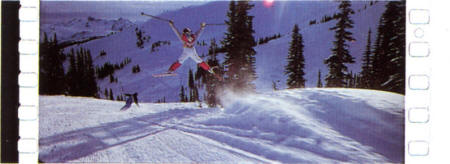 70mm
Showscan frame. Image from the Showscan
brochure. 70mm
Showscan frame. Image from the Showscan
brochure.The Company's principal objectives for the remainder of its current fiscal year are to initiate the production of one or more feature-length motion pictures, to expand the Company's corporate presentation and special-venue businesses and to commercially establish Dynamic Motion Theaters. The Company intends to use a portion of the proceeds of this offering to expand its marketing and advertising programs, including hiring additional necessary marketing personnel. To date, the production of feature-length motion pictures has not been possible because an adequate number of Showscan process cameras and related accessories have not been available. The Company intends to use a portion of the proceeds of this offering to fund the manufacture of a sufficient number of cameras and other equipment necessary for the production of feature-length motion pictures. The Company has entered into an agreement with Cinema Products to manufacture two additional CP-65 cameras and accessories by September 1987. The Company also intends to use a portion of the proceeds of this offering to otherwise invest in, or facilitate the production of, feature-length Showscan motion pictures. |
|||||||||||||||||||||||||||||||
Employees | |||||||||||||||||||||||||||||||
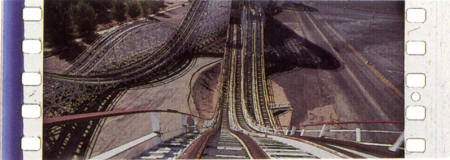 70mm
Showscan frame. Image from the Showscan
brochure. 70mm
Showscan frame. Image from the Showscan
brochure.As of June 1, 1987, the Company had 27 full-time employees, two of whom were employed in management, four were employed in marketing and six were employed in engineering. The remaining 15 full-time employees are administrative and support staff. Five of the executive officers of the Company are part-time employees. In addition, the Company employs certain personnel, including film crews consisting of free-lance directors, writers, artists, technicians, architects and engineers, from time to time on a part-time basis for special-venue projects. Such crews range in size from 25 to 50 persons. Although the Company has not experienced difficulties in obtaining qualified personnel and it anticipates that it will be able to continue to recruit qualified personnel for its operations, there can be no assurance that such personnel will be available when required. 26 The Company is a party to certain industry motion picture union and guild agreements. These agreements require that the Company, in connection with its film production activities, hire only union directors and theatrical employees at specified wage scales with standard fringe benefits. The Company cannot predict the outcome of pending or future union contract negotiations or any renewal terms. The Company considers its relationship with its employees to be satisfactory. |
|||||||||||||||||||||||||||||||
Properties | |||||||||||||||||||||||||||||||
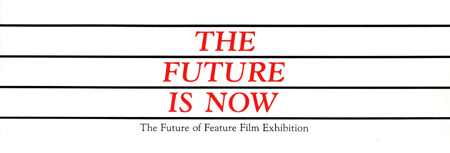 The Company subleases a 37,000-square-foot building
at 3939 Landmark Street, Culver City, California 90232, pursuant to a
sublease expiring on June 30, 1989. The Company has a 14-year option to
lease this property directly from the landlord upon the expiration of
the master lease. The current monthly rental for the premises is
$22,000, subject to annual cost-of-living adjustments. The Company's
operating headquarters, Showscan demonstration theater and film studio
are located at this site. The Company subleases a 37,000-square-foot building
at 3939 Landmark Street, Culver City, California 90232, pursuant to a
sublease expiring on June 30, 1989. The Company has a 14-year option to
lease this property directly from the landlord upon the expiration of
the master lease. The current monthly rental for the premises is
$22,000, subject to annual cost-of-living adjustments. The Company's
operating headquarters, Showscan demonstration theater and film studio
are located at this site.In addition, the Company leases a 9,321-square-foot special effects facility on a month-to-month basis for $6,990 per month, at 4121 Redwood Avenue, Marina del Rey, California 90292. The Company shares its executive offices and facilities with Plitt Entertainment Group, Inc., an affiliate of certain officers and directors of the Company, that is the lessee of the facilities located at 1801 Century Park East, Suite 1225, Los Angeles, California 90067. Until April 1987, the Company did not pay any rent for the use of these facilities. However, the Company has entered into an agreement with Plitt Entertainment Group, Inc., pursuant to which the Company will pay a monthly rental of $5,000 from April 1, 1987 through April 1, 1990 for the use of the office space and other office facilities, office equipment (such as the telephones, computer system, photocopier and typewriter) and certain office personnel. |
|||||||||||||||||||||||||||||||
Management | |||||||||||||||||||||||||||||||
|
Directors and Executive
Officers The current [25.06.1987] directors and executive officers of the Company are as follows: |
|||||||||||||||||||||||||||||||
|
|||||||||||||||||||||||||||||||
 Showscan
logo Showscan
logoHenry G. Plitt has been Co-Chairman of the Board of Directors of the Company since its formation in August 1984. He was Chairman of the Board of Directors and Chief Executive Officer of both Plitt Theatres, Inc. ("PTI") and Plitt Theatre Holdings, Inc. ("PTHI"), companies engaged in the exhibition of motion pictures, from their formation in 1974 and 1978, respectively, until their acquisition by Cineplex Odeon Corporation in November 1985. Mr. Plitt has been the Chairman of the Board of Directors and Chief Executive Officer of Plitt Entertainment Group, Inc. ("PEG") since November 1985. In his 41 years in the motion picture industry, Mr. Plitt has served as President of Paramount-Richards Theatre Circuit, President of ABC Films, Inc., President of Balaban & Katz, Inc. and President of ABC Great States, Inc. Mr. Plitt also has served as a member of the executive committee and as a Vice President of the National Association of Theater Owners. Henry G. Plitt is the father of Edward M. Plitt. |
|||||||||||||||||||||||||||||||
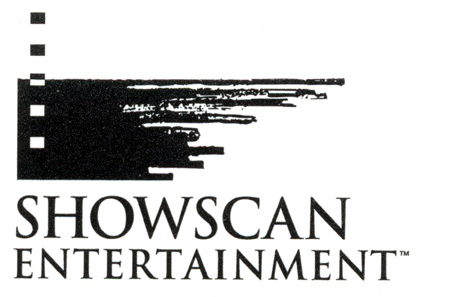 Showscan
logo Showscan
logoDouglas Trumbull has been Co-Chairman of the Board of Directors of the Company since its formation. Mr. Trumbull developed the Showscan process while he was associated with Paramount Pictures Corporation. Mr. Trumbull, an independent motion picture producer and director, has also served as the Chief Executive Officer and a director of High Velocity Films, Inc. (a motion picture production company) since 1981, and as the Chief Executive Officer and a director of FX, Inc. (a company that provides special effects to motion pictures) since 1980. Mr. Trumbull helped create and produce the special effects for "2001: A Space Odyssey", and has served as special photographic effects supervisor for "Close Encounters of the Third Kind", "Star Trek: The Motion Picture" and "Blade Runner". In 1970, he wrote and directed "Silent Running", and in 1983 he directed and produced "Brainstorm". The special effects for "Brainstorm" and "Blade Runner" were completed at Mr. Trumbull's Entertainment Effects Group, a motion-picture production facility that works exclusively in 70mm film. Roy H. Aaron has been President and Chief Executive Officer of the Company since February 1986 and has been a director of the Company since its formation. He also served as President and Chief Operating Officer of PTI and PTHI from 1980 to November 1985. Since November 1985, he has been the President and Chief Operating Officer of PEG. From 1978 to 1980, he served as Senior Vice President and General Counsel to PTI, prior to which time he practiced law in Los Angeles with Pacht, Ross, Warne, Bernhard & Sears. |
|||||||||||||||||||||||||||||||
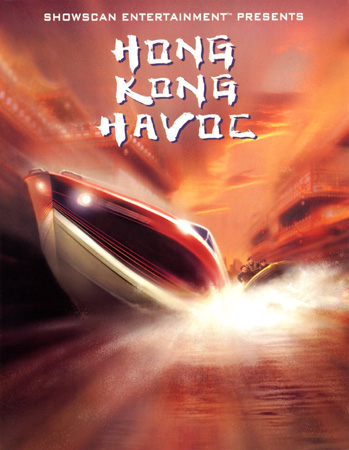 Peter Beale has been the Executive Vice President
of the Company since February 1986. From the formation of the Company to
January 1986, Mr. Beale was the Company's President and Chief Executive
Officer. He has been a director since the Company's formation. Mr. Beale
has served in various capacities in the film production industry for the
past 26 years. He was President of Brock/Trumbull Entertainment
Corporation from August 1983 until April 1985. From July 1980 to August
1983, he was an independent producer, and from 1979 to July 1980, he was
managing director of production and distribution at EMI Films, Ltd. Mr.
Beale was European production representative of Twentieth Century-Fox
Productions, Ltd., London, from 1973 to 1979, during which time he
supervised such productions as "Star Wars", "Alien", "The Omen", "Julia" and
"The
Rocky Horror Picture Show". Peter Beale has been the Executive Vice President
of the Company since February 1986. From the formation of the Company to
January 1986, Mr. Beale was the Company's President and Chief Executive
Officer. He has been a director since the Company's formation. Mr. Beale
has served in various capacities in the film production industry for the
past 26 years. He was President of Brock/Trumbull Entertainment
Corporation from August 1983 until April 1985. From July 1980 to August
1983, he was an independent producer, and from 1979 to July 1980, he was
managing director of production and distribution at EMI Films, Ltd. Mr.
Beale was European production representative of Twentieth Century-Fox
Productions, Ltd., London, from 1973 to 1979, during which time he
supervised such productions as "Star Wars", "Alien", "The Omen", "Julia" and
"The
Rocky Horror Picture Show".James A. Sorensen has been a Financial Vice President, Treasurer and a director of the Company since its formation. Mr. Sorensen also served as Financial Vice President and Treasurer of PTI and PTHI from 1977 and 1978, respectively, to November 1985. From 1972 to 1977, Mr. Sorensen was employed at Urban Investment and Development Company, a real estate developer, in various capacities including Treasurer and Vice President-Finance. Mr. Sorensen is a certified public accountant and was associated with the firm of Ernst & Ernst from 1965 to 1972. He also has been Financial Vice President, Secretary, a director and Treasurer of PEG since November 1985. Raymond C. Fox has been a director of the Company since November 1985 and the Secretary since April 1, 1987. From 1974 to November 1985, he was Senior Vice President of PTI, and from 1980 to November 1985, he was Secretary of PTI and PTHI. Mr. Fox was a director of these two companies from October 1983 to November 1985. He has been a Senior Vice President and a director of PEG since November 1985. |
|||||||||||||||||||||||||||||||
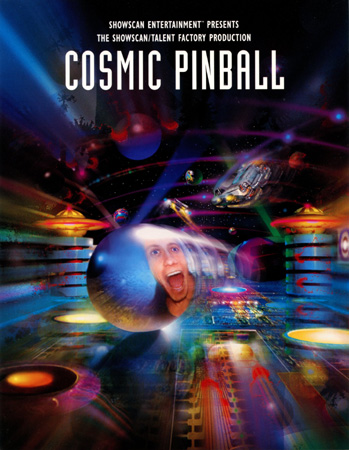 John B. R. Leisner has been a director of the
Company since February 1987. In addition, Mr. Leisner has been the Chief
Executive Officer of John Leisner & Associates, a management consulting
firm since September 1985. Mr. Leisner was President of San Diego Fox
Productions, a company that operated a live theater, and John Leisner &
Associates from August 1981 to February 1983, Director of Spectator
Services of the Los Angeles Olympic Organizing Committee from February
1983 to September 1984, and President of Pizza Time Theater, Inc. from
September 1984 to September 1985. From 1975 to 1981, Mr. Leisner was
Chief Operating Officer of the Universal Studios Tour and Amphitheater,
which is owned and operated by MCA, Inc. John B. R. Leisner has been a director of the
Company since February 1987. In addition, Mr. Leisner has been the Chief
Executive Officer of John Leisner & Associates, a management consulting
firm since September 1985. Mr. Leisner was President of San Diego Fox
Productions, a company that operated a live theater, and John Leisner &
Associates from August 1981 to February 1983, Director of Spectator
Services of the Los Angeles Olympic Organizing Committee from February
1983 to September 1984, and President of Pizza Time Theater, Inc. from
September 1984 to September 1985. From 1975 to 1981, Mr. Leisner was
Chief Operating Officer of the Universal Studios Tour and Amphitheater,
which is owned and operated by MCA, Inc.Edward M. Plitt has been Vice President—Administration of the Company since January 1987 and was a consultant to the Company from November 1985 to January 1987. From 1977 to November 1985, Mr. Plitt was a Vice President of PTI. |
|||||||||||||||||||||||||||||||
|
Go: back - top - back issues - news index Updated 22-01-25 |
